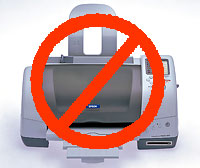 Although I know that shouting at computer components is unlikely to make them magically fix themselves, it somehow makes me feel a bit better.
Although I know that shouting at computer components is unlikely to make them magically fix themselves, it somehow makes me feel a bit better.
Hard drives, monitors, soundcards and even keyboards have all felt the sharp lash of my tongue when they decide to stop working properly, but there is only one component that gets me so angry that I want to lob the fecking thing out of the window.
My useless Epson
Yep, we’re talking about my printer. My useless Epson Photo 985.
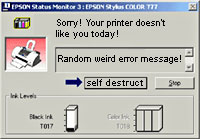 Cursed with a jazz approach to functionality, it’s a moody number with a teenager’s approach to getting up.
Cursed with a jazz approach to functionality, it’s a moody number with a teenager’s approach to getting up.
Sometimes it decides that it doesn’t want to be disturbed from its nap, and no amount of bashing buttons or whispering encouraging words into its nozzles will change that fact.
Other times, it will burst into life with such enthusiasm I can only assume it’s ingested some sort of ink-based amphetamine, as reams of (often unrequested) copies keep on spitting out of the printer.
Flaky printer
To be fair, the Epson’s been a bit flaky for some time, although it only started really playing up a few days after its guarantee period expired (cue conspiracy theories about manufacturers building in pre-planned obsolescence. Or the printer just knowing).
Despite its quirks, it’s usually got there in the end after some shouting and prodding, so I’ve persevered with it over the years.
That is until this weekend, when it decided to go really downhill, with a near terminal decline timed to perfectly coincide with the delivery of a box of expensive new Epson inks (and yes, I have been buying the proper inks, despite the eye-wateringly expensive prices).
Picasso in a box
My printer clearly harbours some artistic ambitions, getting creative with my printouts by adding random lines, banding and sometimes even a psychedelic effect where individual colours are removed.
 Naturally, the ‘clean heads’ option has little effect (apart from draining £££ inks at an accelerated rate) but just when I’m about to give up on the thing completely – whoosh! out comes a perfect print, with deep blacks and vibrant colours.
Naturally, the ‘clean heads’ option has little effect (apart from draining £££ inks at an accelerated rate) but just when I’m about to give up on the thing completely – whoosh! out comes a perfect print, with deep blacks and vibrant colours.
Sometimes it does this to lull me into a false sense of security: if I need to produce a photo quality print for a client, it’ll produce a perfect test print on bog standard paper, but as soon as it detects the lush lustre of expensive photographic paper, out come the usual streaks, bands and missing colours.
As an added tease, it’s also partial to starting off with a prefect print, and then letting the image slowly degrade until there’s barely a ghostly image left at the end of the page.
Hide and seek
It’s not all moody misprints though, with the Epson liking to wind up my desktop PC with prolonged hide and seek sessions.
I’ll be working on a document, I’ll press ‘print’ and – wooargh! – the computer’s telling me that the printer has somehow vanished off the face of the earth but, no – it’s still right there on the shelf in front of me.
Cue much red-faced shouting in Digi-Lifestyles towers:
“WHAT DO YOU MEAN YOU CAN’T FIND THE PRINTER?! It’s right there – look! – where it’s always been. RIGHT NEXT TO YOU, you useless piece of crap!”
Even when the Epson has deigned to let the desktop speak to it, the printer will suddenly shun all requests to print a document, producing a baffling ‘communication error’ onscreen.
This basically means, “there is nothing you can do now until we decide to let you print again.”
The only way to defeat this electronic rebellion is to reboot the machine – which can be a right pain when you’re in the middle of something.
Mind you, it won’t forget about those documents that it’s refused to print, so even when I’ve cancelled the print run and sent it to another printer and rebooted my PC, the Epson will suddenly spring into life – sometimes days later – and churn out endless copies of a cancelled document that it’s been secretly harbouring in its cache.
Like Hal in 2001, the Epson doesn’t like to be turned off either, so attempts to cancel ‘stuck’ documents by switching off the printer can be punished with an unexpected PC system reboot (how does it do that?!).
No one could accuse me of not trying to get the thing working either: it’s been uninstalled, reinstalled, moved about and plugged into a host of different USB ports and computers.
It’s had new drivers, old drivers, Peruvian incantations and prayers to the great Gods of the Ink Droplets.
Sing-a-longa-Epson
Occasionally, the printer takes a dislike to the music being played in the office and decides to start up a tune of its own, settling down to enjoy an elongated period of experimental electronic music involving random whirring, hissing and whining noises.
This mechanical racket can go on for some time, with long, teasing pauses in-between leaving me unable to concentrate as I wait for the next irritating bout of shuffling to kick in.
 It knows when things are urgent
It knows when things are urgent
One thing I can guarantee with near 100% certainly is that the really big printer problems will rear their head whenever there’s some sort of urgency involved.
About to go out and need to print off map directions? Cue instant printer meltdown!
Need to print out a letter in time for the last post? What better time for a random error message to appear!
Have to send off an urgent document? The perfect time for the ink readout to go from 75% to zero mid-print!
Conclusion
The very fact that I’ve found myself ranting so long about a bloody printer tells me that it’s high time I dumped the chump and bought a new one.
Which I’d love to do, except I’ve got that big pile of freshly purchased ink cartridges sitting unused on my desk (naturally, they’re only compatible with a handful of current printers and only work with Epson), so me and Epson are going to have to stick it out for a bit longer. It’ll be like Thatcher and Scargill stuck on a small desert island.
Meanwhile, my girlfriend’s older, cheaper, bottom-of-the-range printer continues to churn out top quality prints day after day.
Maybe she’s just got a better relationship with her printer than me.
 One thing the Web is great for is reaching out to a potential audience of millions to garner support for your cause.
One thing the Web is great for is reaching out to a potential audience of millions to garner support for your cause. To further promote Tony’s cause the author has invited surfers to sign a petition to register their support, with a form inviting people to enter their name, email address and short comment.
To further promote Tony’s cause the author has invited surfers to sign a petition to register their support, with a form inviting people to enter their name, email address and short comment. Before long, posters had worked out how to add pretty colours to their signatures and then moved on to embedding images.
Before long, posters had worked out how to add pretty colours to their signatures and then moved on to embedding images.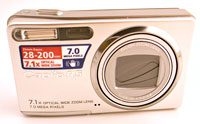 Fresh out of Japan is the new Caplio R5 digital camera, featuring anti-shake, a new 7.24 megapixel CCD and the same mighty 7.1x optical wide zoom lens (28-200mm, 35mm equiv) as seen on its predecessor, the Caplio R4 (
Fresh out of Japan is the new Caplio R5 digital camera, featuring anti-shake, a new 7.24 megapixel CCD and the same mighty 7.1x optical wide zoom lens (28-200mm, 35mm equiv) as seen on its predecessor, the Caplio R4 ( We can’t say we liked this move, as the smaller, recessed power button is much harder to operate (we also had issues with powering up the camera, but we’ll move on to that later).
We can’t say we liked this move, as the smaller, recessed power button is much harder to operate (we also had issues with powering up the camera, but we’ll move on to that later).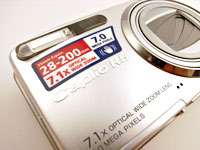 LCD screen
LCD screen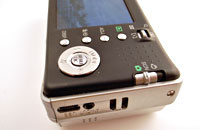 Seeing as the assistant was most unimpressed with our antics we had to cut short our testing, so we can only assume that the differences would manifest themselves under more demanding light conditions or under closer scrutiny.
Seeing as the assistant was most unimpressed with our antics we had to cut short our testing, so we can only assume that the differences would manifest themselves under more demanding light conditions or under closer scrutiny.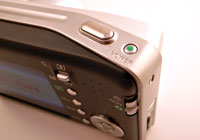 The LCD screen was easy to read (although, being London in September, the sun wasn’t exactly blinding), but we would have liked to have seen an optical viewfinder in there too.
The LCD screen was easy to read (although, being London in September, the sun wasn’t exactly blinding), but we would have liked to have seen an optical viewfinder in there too. Night time woes
Night time woes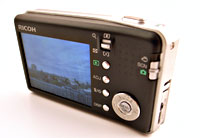 Noisy nights
Noisy nights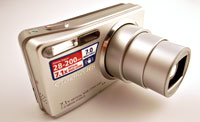 Street photographers looking to grab late night sneaky shots with the camera on 10 second self timer will have to think again too as the flash – yes the FLASH! – blinks brightly on and off during the countdown!
Street photographers looking to grab late night sneaky shots with the camera on 10 second self timer will have to think again too as the flash – yes the FLASH! – blinks brightly on and off during the countdown!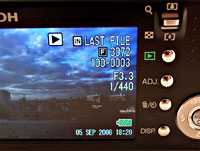 We had some problems with that the SD slot, with a worrying ‘card format’ error popping up unexpectedly halfway through a shoot.
We had some problems with that the SD slot, with a worrying ‘card format’ error popping up unexpectedly halfway through a shoot.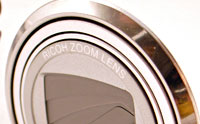 Spot
Spot Like most Brits we’re more than a bit obsessed with all things weather-related, so as soon as we bought a Palm Treo we were busily installing a host of weather-related applications, including
Like most Brits we’re more than a bit obsessed with all things weather-related, so as soon as we bought a Palm Treo we were busily installing a host of weather-related applications, including 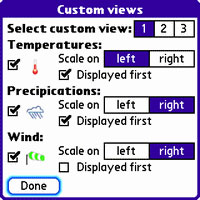 Setting it all up
Setting it all up Wind speeds can be shown in km/h, mph, m/s, knots or in the trusty old Beaufort Scale, with the choice to select temperature readouts in Celsius or old school Fahrenheit.
Wind speeds can be shown in km/h, mph, m/s, knots or in the trusty old Beaufort Scale, with the choice to select temperature readouts in Celsius or old school Fahrenheit. At just €9.95 the program represents great value to our eyes and looks to be an essential purchase for travellers and meteorological mullers.
At just €9.95 the program represents great value to our eyes and looks to be an essential purchase for travellers and meteorological mullers.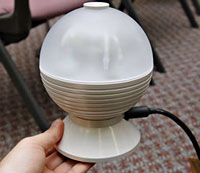 We can’t say we like the thought of being bombarded by different whiffs while we’re listening to the radio, but it seems someone in Japan liked the idea so much that they’re about to launch a fragrance-pumpin’ product in October.
We can’t say we like the thought of being bombarded by different whiffs while we’re listening to the radio, but it seems someone in Japan liked the idea so much that they’re about to launch a fragrance-pumpin’ product in October. The gadget connects to your desktop via USB, with the PC downloading the aroma instructions from the radio station via the Internet, with odorous wafts synchronised to match whatever song is currently being played.
The gadget connects to your desktop via USB, with the PC downloading the aroma instructions from the radio station via the Internet, with odorous wafts synchronised to match whatever song is currently being played. The USB Aroma Geur is available for 49,900 Yen ($430), with the service scheduled to start up in Japan from 2nd October 2006.
The USB Aroma Geur is available for 49,900 Yen ($430), with the service scheduled to start up in Japan from 2nd October 2006. A new report from anti virus firm SoftScan has revealed that spam levels remain hideously high at 87.72% of all email traffic, while reports of phishing activity have soared.
A new report from anti virus firm SoftScan has revealed that spam levels remain hideously high at 87.72% of all email traffic, while reports of phishing activity have soared.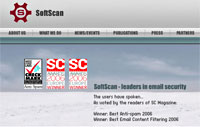 Spam levels are expected to reduce by a few per cent soon, with the post-summer holiday rise in legitimate business email pushing the spam percentage back down to its usual level of around 85 per cent.
Spam levels are expected to reduce by a few per cent soon, with the post-summer holiday rise in legitimate business email pushing the spam percentage back down to its usual level of around 85 per cent. We’ve already told you about the electronics-focussed and very blokey Make: magazine, but they’ve now got competition in the shape of a soon-come sister publication called Craft:, which is aimed at the “new alternative craft movement.”
We’ve already told you about the electronics-focussed and very blokey Make: magazine, but they’ve now got competition in the shape of a soon-come sister publication called Craft:, which is aimed at the “new alternative craft movement.” In line with its hip Web 2.0 aspirations, the magazine comes with an interactive website offering tons of links to ‘craft mafia’ clubs, an online blog, projects, magazine features and a clever idea to deliver knitting patterns over iTunes.
In line with its hip Web 2.0 aspirations, the magazine comes with an interactive website offering tons of links to ‘craft mafia’ clubs, an online blog, projects, magazine features and a clever idea to deliver knitting patterns over iTunes.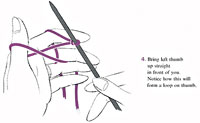 The magazine are trialling the service now, so mad-for-it crafters can download a pattern for a stretch tube top with drawstring bottom, hipster shorts with scoop sides (whatever that is) from
The magazine are trialling the service now, so mad-for-it crafters can download a pattern for a stretch tube top with drawstring bottom, hipster shorts with scoop sides (whatever that is) from  Fun, funky and painfully hip, the Craft: website is already a great resource for DIY types looking for inspiration and ideas, and makes a pleasant change from the usual corporate homogenised dreck that we keep getting press releases about.
Fun, funky and painfully hip, the Craft: website is already a great resource for DIY types looking for inspiration and ideas, and makes a pleasant change from the usual corporate homogenised dreck that we keep getting press releases about. In a move that was as unexpected as night following day, MySpace has finally revealed plans to introduce its own music downloads service before the end of the year.
In a move that was as unexpected as night following day, MySpace has finally revealed plans to introduce its own music downloads service before the end of the year. Now the most visited site in the US, MySpace boasts millions of users with the site already established as an essential part of any new band’s online promotional activities.
Now the most visited site in the US, MySpace boasts millions of users with the site already established as an essential part of any new band’s online promotional activities. This gets around Apple’s stubborn refusal to licence their FairPlay digital rights management system to third parties, letting music fans play purchased tracks on their iPods.
This gets around Apple’s stubborn refusal to licence their FairPlay digital rights management system to third parties, letting music fans play purchased tracks on their iPods.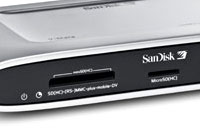 Although there’s no shortage of gadgets like smartphones, PDAs, iPod and PSPs that are capable of playing back video, getting footage on to the fellas can be a bit of a pain.
Although there’s no shortage of gadgets like smartphones, PDAs, iPod and PSPs that are capable of playing back video, getting footage on to the fellas can be a bit of a pain. Users can connect the V-Mate to the AV output of their video recorder, set-top box, Freeview, DVR, DVD player, TV or other device and use the V-Mate’s remote control to configure the device, plus record and access content via a TV-based interface.
Users can connect the V-Mate to the AV output of their video recorder, set-top box, Freeview, DVR, DVD player, TV or other device and use the V-Mate’s remote control to configure the device, plus record and access content via a TV-based interface.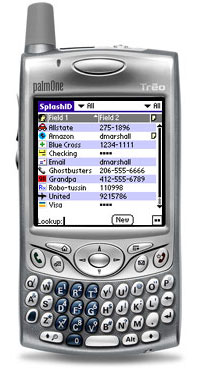 If you’re a modern, go-getting metrosexual-about-town like us Digi-Life hipsters, you’ll be the owner of a mile-long list of passwords, web logins, ATM PINs, program serials, bank account details, credit card numbers and passcodes for highly exclusive West End nightclubs.
If you’re a modern, go-getting metrosexual-about-town like us Digi-Life hipsters, you’ll be the owner of a mile-long list of passwords, web logins, ATM PINs, program serials, bank account details, credit card numbers and passcodes for highly exclusive West End nightclubs.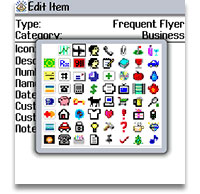 Using SplashID
Using SplashID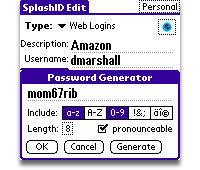 Naturally, with all your precious data a mere password away, it’s vital that you make your SplashID password a good ‘un – if that kind of thing defeats you, there’s a handy password generator onboard to help you create hard-to-crack passwords.
Naturally, with all your precious data a mere password away, it’s vital that you make your SplashID password a good ‘un – if that kind of thing defeats you, there’s a handy password generator onboard to help you create hard-to-crack passwords.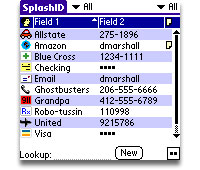 A nice touch is that you can click the clipboard icon next to listed passwords and have the code automatically placed in the clipboard ready for pasting into your browser or program password box.
A nice touch is that you can click the clipboard icon next to listed passwords and have the code automatically placed in the clipboard ready for pasting into your browser or program password box.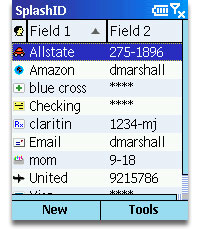 Because of SplashID’s cross-platform abilities, we’ve been able to exchange data from Palm to Windows Mobile devices (and back again) without a problem so it’s pretty much future proofed, and the desktop integration is a great way of ensuring that the info is kept up to date.
Because of SplashID’s cross-platform abilities, we’ve been able to exchange data from Palm to Windows Mobile devices (and back again) without a problem so it’s pretty much future proofed, and the desktop integration is a great way of ensuring that the info is kept up to date.